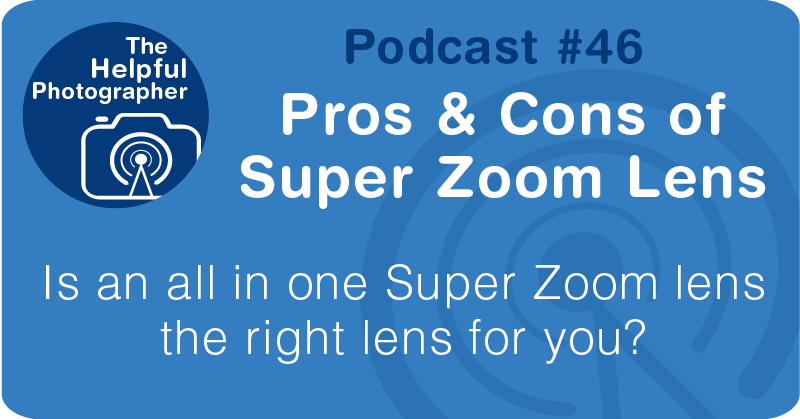Pros & Cons of a Super Zoom Lens #46
Photo Tips Podcast: Pros & Cons of a Super Zoom Lens #46

iTunes
Google
Spotify
Tune In
Stitcher
RSS
Pandora
Photo Tips Podcast: Pros & Cons of a Super Zoom Lens #46
After recording last week’s podcast about which lens to buy next. A participant asked me if I could recommend a new lens for him. One that would “upgrade” his camera by moving to a more universal lens that would require fewer lens changes rather than continuing with the two kit lenses that came with his camera. Which is the 18-55 and 55-250mm lenses. In other words something like the 18-200mm or the 18-300mm lenses; these are sometimes referred to as “superzooms”. As I said in the previous podcast, prime lenses are actually quite sharp and this is because they do one thing and they do that one thing very well, but you pay a very heavy price in back pain and limited usability for that benefit. So the argument against zoom lenses is that they are not as sharp because they attempt to do too many things. My argument is that although this is true, if you are buying a very good zoom lens, especially the pro-rated lenses, most photographers probably wouldn’t notice the difference when you compare images and the sharpness discussion is mostly academic and not a practical one.
Another limitation of zoom lenses is that they tend to be what we call slow; in other words they’re incapable of gathering as much light as prime lenses. And in photography we’re constantly looking to gather more light. As a result these lenses are not very good for people who are shooting things like indoor sports, or anything moving under low light. And it should be noted that consumer rated zoom lenses are even slower than pro-rated zoom lenses. But as always pro-rated lenses are accompanied by a much bigger sticker prices and greater back pain as they are significantly larger as well.
The last limitation that should be noted is that sometimes long zoom lenses can be a little sluggish when it comes to autofocus especially when you are shooting on the long side of the lens. I’m not sure what causes this, I just know this is what I’ve experienced after handling thousands of consumer rated lenses participants have brought out to safaris here in New York City.
As you can see there are some potential downfalls to zoom lenses, but I would be remiss if I did not reiterate that the problems I just mentioned are mostly relegated to consumer rated zoom lenses attached to consumer rated camera bodies and all superzooms are consumer rated lenses. And this is why I have personally not run into many of the problems with my set-up mostly because I shoot pro-rated zoom lenses. I know many of you will argue that you do not have any of these issues with your zoom lenses but again it depends on what you are shooting in combination with the lens you are shooting with. I know that many photographers very much enjoy shooting superzooms because they don’t have to change lenses and because the results meet their needs. I am also aware that you can get great results out of these lenses, but that requires understanding their limitations and knowing how to push those limitations to get those amazing results. But one thing for sure, the longer the range the more problems you are likely to run into. And a superzoom certainly has a huge range and falls into the category of Jack of all trades and definitely master of none.
So whether or not a superzoom is right for you really depends on what you tend to shoot most often and what you think is important.











